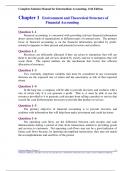Exam (elaborations)
Solution Manual For Intermediate Accounting, 11th Edition by David Spiceland, Mark Nelson, Wayne Thomas, Jennifer
Solution Manual For Intermediate Accounting, 11th Edition by David Spiceland, Mark Nelson, Wayne Thomas, Jennifer Both online and in PDF Immediately available after payment . 100% Money Back Guarantee
[Show more]
Preview 4 out of 3525 pages
Uploaded on
November 29, 2023
Number of pages
3525
Written in
2023/2024
Type
Exam (elaborations)
Contains
Questions & answers
Institution
Solution
Course
Solution
$19.99
100% satisfaction guarantee
Immediately available after payment
Both online and in PDF
No strings attached
Complete Solution Manual for Intermediate Accounting, 11th Edition Solutions Manual, Chapter 2 2–1 © McGraw Hill LLC. All rights reserved. No reproduction or distribution without the prior written consent of McGraw Hill LLC. Question 1 –1 Financial accounting is concerned with providing relevant financial information about various kinds of organizations to different types of external users. The primary focus of financial accounting is on the financial information provided by profit -





